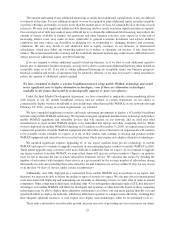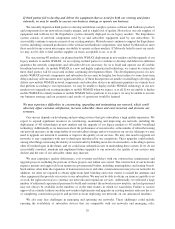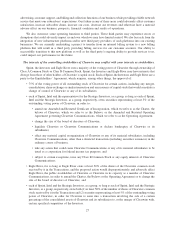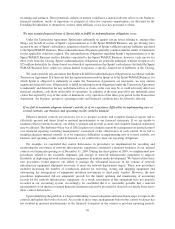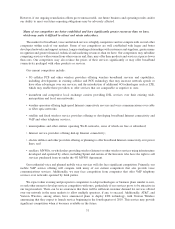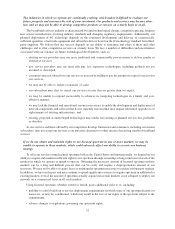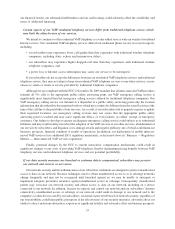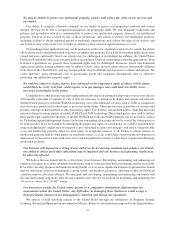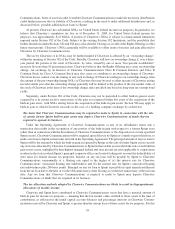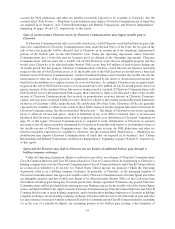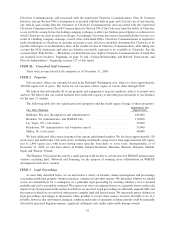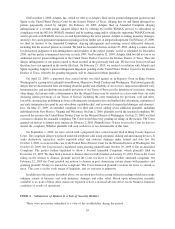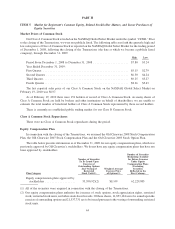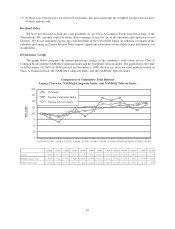Clearwire 2009 Annual Report Download - page 45
Download and view the complete annual report
Please find page 45 of the 2009 Clearwire annual report below. You can navigate through the pages in the report by either clicking on the pages listed below, or by using the keyword search tool below to find specific information within the annual report.our
fi
nanc
i
a
l
resu
l
ts, our su
b
stant
i
a
li
n
d
e
b
te
d
ness an
d
our cre
di
t rat
i
ngs cou
ld
a
d
verse
l
ya
ff
ect t
h
eava
il
a
bili
ty an
d
t
erms o
f
a
ddi
t
i
ona
lfi
nanc
i
ng.
C
ertain as
p
ects o
f
our VoIP resi
d
entia
l
te
l
e
ph
on
y
services
d
i
ff
er
f
rom tra
d
itiona
l
te
l
e
ph
one service, w
h
ic
h
m
a
yl
imit t
h
e attractiveness o
f
our services
.
We intend to continue to offer residential VoIP telephon
y
as a value added service with our wireless broadban
d
Internet service. Our residential VoIP telephon
y
services differ from traditional phone service in several respects
,
i
ncluding
:
• our su
b
scr
ib
ers ma
y
exper
i
ence
l
ower ca
ll
qua
li
t
y
t
h
an t
h
e
y
exper
i
ence w
i
t
h
tra
di
t
i
ona
l
w
i
re
li
ne te
l
ep
h
one
c
ompanies, includin
g
static, echoes and transmission dela
y
s
;
• our subscribers may experience higher dropped-call rates than they experience with traditional wireline
te
l
ep
h
one compan
i
es; an
d
• a power loss or Internet access interruption ma
y
cause our service to be interrupted
.
If
our su
b
scr
ib
ers
d
o not accept t
h
e
diff
erences
b
etween our res
id
ent
i
a
l
VoIP te
l
ep
h
ony serv
i
ces an
d
tra
di
t
i
ona
l
t
e
l
ep
h
one serv
i
ce, t
h
ey may not a
d
opt or
k
eep our res
id
ent
i
a
l
VoIP te
l
ep
h
ony serv
i
ces or our ot
h
er serv
i
ces, or may
ch
oose to reta
i
n or return to serv
i
ce prov
id
e
dby
tra
di
t
i
ona
l
te
l
ep
h
one compan
i
es.
Although we are compliant with the FCC’s November 28, 200
5
mandate that all interconnected VoIP provider
s
t
ransmit all 911 calls to the appropriate public safety answering point, our VoIP emergency calling service is
si
gn
ifi
cant
l
y more
li
m
i
te
d
t
h
an t
h
e emergency ca
lli
ng serv
i
ces o
ff
ere
db
y tra
di
t
i
ona
l
te
l
ep
h
one compan
i
es. Ou
r
V
oIP emergency ca
lli
ng serv
i
ce can transm
i
ttoa
di
spatc
h
er at a pu
bli
csa
f
ety answer
i
ng po
i
nt on
l
yt
h
e
l
ocat
i
on
i
n
f
ormat
i
on t
h
at t
h
esu
b
scr
ib
er
h
as reg
i
stere
d
w
i
t
h
us, w
hi
c
h
may at t
i
mes
b
e
diff
erent
f
rom t
h
e actua
ll
ocat
i
on at t
h
e
ti
me o
f
t
h
eca
ll d
ue to t
h
e porta
bili
ty o
f
our serv
i
ces. As a resu
l
t,
if
our su
b
scr
ib
ers
f
a
il
to proper
l
y reg
i
ster or up
d
at
e
th
e
i
r reg
i
stere
dl
ocat
i
ons, our emergency ca
lli
ng systems may not assure t
h
at t
h
e appropr
i
ate pu
bli
csa
f
et
y
answer
i
ng po
i
nt
i
s reac
h
e
d
an
d
may cause s
i
gn
ifi
cant
d
e
l
ays, or even
f
a
il
ures,
i
nca
ll
ers’ rece
i
pt o
f
emergency
ass
i
stance. Our
f
a
il
ure to
d
eve
l
op or operate an a
d
equate emer
g
enc
y
ca
lli
n
g
serv
i
ce cou
ld
su
bj
ect us to su
b
stant
i
a
l
li
a
bili
t
i
es an
d
ma
y
resu
l
t
i
n
d
e
l
a
y
s
i
nsu
b
scr
ib
er a
d
opt
i
on o
f
our VoIP serv
i
ces or our ot
h
er serv
i
ces, a
b
an
d
onment o
f
our services b
y
subscribers, and liti
g
ation costs, dama
g
e awards and ne
g
ative publicit
y
,an
y
of which could harm ou
r
business, prospects, financial condition or results of operations. In addition, our deplo
y
ment of mobile intercon-
n
ected VoIP services faces additional E911 re
g
ulator
y
uncertaint
y
, as discussed above in “Business — Re
g
ulator
y
Matters — Interconnected VoIP services re
g
ulation.
”
F
i
na
lly
, potent
i
a
l
c
h
an
g
es
by
t
h
e FCC to current
i
ntercarr
i
er compensat
i
on mec
h
an
i
sms cou
ld
resu
l
t
i
n
sig
n
ifi
cant c
h
an
g
es to our costs o
f
prov
idi
n
g
VoIP te
l
ep
h
on
y
,t
h
ere
by
e
li
m
i
nat
i
n
g
pr
i
c
i
n
gb
ene
fi
ts
b
etween VoI
P
t
elephon
y
services and traditional telephone services and our potential profitabilit
y.
I
f our data security measures are breached or customer data is compromised, subscribers may perceive
o
ur network
a
nd services
a
s not secure.
Our network securit
y
and the authentication of our subscriber credentials are desi
g
ned to protect unauthorize
d
access to data on our network. Because techniques used to obtain unauthorized access to or to sabotage networks
c
hange frequently and may not be recognized until launched against us, we may be unable to anticipate or
i
mp
l
ement a
d
equate prevent
i
ve measures aga
i
nst unaut
h
or
i
ze
d
access or sa
b
otage. Consequent
l
y, unaut
h
or
i
ze
d
p
art
i
es may overcome our networ
k
secur
i
ty an
d
o
b
ta
i
n access to
d
ata on our networ
k
,
i
nc
l
u
di
ng on a
d
ev
i
ce
c
onnecte
d
to our networ
k
.Ina
ddi
t
i
on,
b
ecause we operate an
d
contro
l
our networ
k
an
d
our su
b
scr
ib
ers’ Internet
c
onnect
i
v
i
t
y
, unaut
h
or
i
ze
d
access or sa
b
ota
g
eo
f
our networ
k
cou
ld
resu
l
t
i
n
d
ama
g
e to our networ
k
an
d
to t
h
e
c
omputers or ot
h
er
d
ev
i
ces use
dby
our su
b
scr
ib
ers. An actua
l
or perce
i
ve
db
reac
h
o
f
networ
k
secur
i
t
y
,re
g
ar
dl
ess o
f
our respons
ibili
t
y
, cou
ld h
arm pu
bli
c percept
i
on o
f
t
h
ee
ff
ect
i
veness o
f
our secur
i
t
y
measures, a
d
verse
ly
a
ff
ect ou
r
abilit
y
to attract and retain subscribers, expose us to si
g
nificant liabilit
y
and adversel
y
affect our business prospects.
35


